While the North Stars thrived in the hockey hotbed of Minnesota, the situation in California got off to a rocky start. San Francisco was not considered a particularly lucrative market for hockey, but the terms of the new television agreement the league had signed with CBS called for two of the six new expansion clubs to be located in California.
The Seals were supposed to have been located in San Francisco, but the planned arena was never built. Instead, the team was based across the bay in Oakland. The club was originally called the "California Seals" to appeal to fans in the larger San Francisco and address complaints from the other NHL team, who thought Oakland was not a major league city, as it's only other professional sports team at the time was the Oakland Raiders of the second rate American Football League. Then, on November 6, 1967, after having played just a dozen games, owner Barry Van Gerbig announced the team's name was being changed to the "Oakland Seals"!
The Oakland Seals were then purchased by Charlie O. Finley, owner of the Oakland Athletics baseball club, who had moved to the bay area in 1968. Never one to sit still, Finley renamed the team the "California Golden Seals" and changed the team's colors from green and blue to green and gold to match those worn by his baseball club, as well as having the team wear flashy white skates!
Once relocated for the 1976-77 season, the franchise was renamed the Cleveland Barons and took up residence in the Richfield Coliseum, giving them the largest seating capacity in the NHL at the time of 18,544, but they would never come close to filling it in the two years they played in Cleveland. Their 1976 home opener drew only 8,900 fans and they attracted 10,000 at only seven out of their 40 home games.
With serious concerns that both clubs were on the verge of folding, on June 13, 1978, the league granted approval for the Barons to merge with the Minnesota North Stars under the Gunds ownership. The team would play in Minnesota and retain the North Stars name, but take the Barons place in the Adams Division. The Barons remain the last franchise in the four major North American sports leagues to cease operations.
Things had to happen fast, as the 1978 NHL Amateur Draft was just two days away and a special dispersal draft for the excess players from the combined rosters needed to be held first. The new North Stars were allowed to protect 10 players and two goaltenders from the combined rosters of Cleveland and Minnesota prior to the dispersal draft, in which any team wanting to claim an unprotected player could do so for $30,000.
Working quickly for the freshly merged club, Minnesota's brand new General Manager Lou Nanne (who had only stopped playing at the end of the just completed season!) and Cleveland's GM Harry Howell (who became the combined team's head coach) evaluated their recently combined roster and protected Per-Olav Brasar, Brad Maxwell, Bryan Maxwell, Glen Sharpley, Tim Young and goaltender Pete LoPresti from the North Stars roster and Mike Fidler, Rick Hampton, Al MacAdam, Dennis Maruk, Greg Smith and goaltender Gilles Meloche from the Barons.
Only the five worst teams were allowed to make selections from the unprotected players in the Dispersal Draft, held on this date in 1978, and the Washington Captials chose to pass, and were instead allowed to make an additional pick at the end of the first round of the 1978 Amateur Draft.
After the St. Louis Blues chose Mike Crombeen from the Barons roster, the North Stars were allowed to protect an additional player, which was Ron Zanussi. The Vancouver Canucks then chose Randy Holt, also formerly of the Barons. After the Pittsburgh Penguins passed on their chance to select a player, Bob Stewart was then added to the protected list by Minnesota. The Dispersal Draft then concluded when the Colorado Rockies declined their chance to select a player.
The newly merged roster was then immediately supplemented later the same day by the North Stars having the first overall pick in the 1978 NHL Amateur Draft thanks to Minnesota having finished dead last in the league at the end of the 1977-78 season. They chose eventual NHL Rookie of the Year and future team captain Bobby Smith in the first round and his Ottawa 67's linemate Steve Payne in the second round, both of whom would go on to be 40 goal scorers for the North Stars. They then hit on future Miracle on Ice team member Steve Christoff later in the second round, who would score 26 goals twice for the North Stars and excel as a penalty killer, and another future team captain, defenseman Curt Giles in the fourth round.
In addition to those protected in the dispersal draft and chosen in the Amateur Draft, the team was also able to retain several players who were not chosen in the Dispersal Draft despite not being protected. Among those were Tom Younghans, Fred Barrett and Bill Butters off the North Stars roster and the return to Minnesota of J. P. Parise from Cleveland as well as goaltender Gary Edwards, who supplanted LoPresti as Meloche's backup, playing in 25 games in 1978-79.
they merged with the Cleveland Barons
The critics said if you combined the rosters of two terrible teams, you were going to be left with a terrible team, but the combined talents of of the two teams plus the addition of their draft class of 1978 proved them wrong. While they did miss out on the playoffs in 1979, the 1979-80 roster reached the playoff Semifinals.
Then the 1980-81 team, who by now had Christoff and Giles plus 1979 draft picks Craig Hartsburg and homegrown Neal Broten plus electrifying undrafted free agent Dino Ciccarelli (who was passed over after having suffered a broken leg in juniors), veteran Paul Shmyr, tough guy Jack Carlson and rookie goaltender Don Beaupre, made it to the Stanley Cup Finals in the space of three short seasons after having finished dead last in the NHL.
It would take 22 years before the NHL would return to Ohio, but not to Cleveland, as the new team would be in the form of the Columbus Blue Jackets in 2000-01.
After the departure of owner Finley, the Golden Seals colors were changed from his signature green and gold to the even less intimidating shades of "Pacific Blue" (teal) and "California Gold" (yellow), quite probably the worst colors ever for an NHL team, which were about as intimidating as Easter eggs. The change also gave the team more total color schemes than playoff appearances as well.
Today's second featured jersey is a 1976-77 Cleveland Barons Gilles Meloche jersey. Made by ProJoy at a time when replicas were less than accurate. While this jersey has it's issues, like the sleeve stripes being straight instead of angled, the crest is very well made, with each piece being a separate piece of fabric sewn together. The Gothic "B" in the state of Ohio in the center of the main logo is five separate layers of fabric and both the curved "Cleveland" and "Barons" names are each intricate single pieces of twill sewn onto the "C"!

A name on the back of a Barons road jersey with the State of Ohio sleeve patches? That didn't add up, so we posted the photo on a collector forum and questioned wether it was perhaps from a pre-season game before the 77-78 season.
Due to the fact their game was going to be shown on national TV, the Barons were required at the request of the network to add names to the back of the jerseys, which were then removed after the game because the team owners thought that having names on the back of the player's jerseys would hurt their program sales.
Today's third featured jersey is a 1983-84 Minnesota North Stars Gilles Meloche jersey. An interesting fact about Meloche is that he played for the California Golden Seals from 1971-72 to 1975-76, the Cleveland Barons in both 1976-77 and 1977-78 and then the Minnesota North Stars from 1978-79 to the 1984-85 season, 14 seasons in all with three different teams without once ever having being traded or signing a free agent contract as the Seals relocated to Cleveland and the Barons then merged with the North Stars.
Joining Meloche on the journey from California to Cleveland to Minnesota was MacAdam and technically Greg Smith (1 game as a rookie with the Seals before their move to Cleveland) and Maruk, who was traded to Washington after just two games with the North Stars (only to return to Minnesota five years later).
We doubt if any other players ever had so much discontinuity in such a continuous career as Meloche (14 seasons with three teams but no trades or free agent signings) and MacAdam (10 seasons of the same)!
The North Stars ushered in their new era of Gund's ownership with a new style of jersey, dropping the dual waist and arm stripes of the same color by changing to dual two color stripes of the same width. While the white home jerseys got the addition of black trim back in 1981-82, the green road jerseys did not have the addition of the striking black accent color until 1988-89.

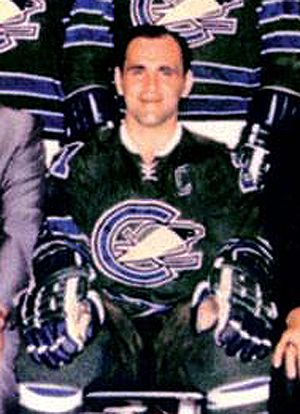
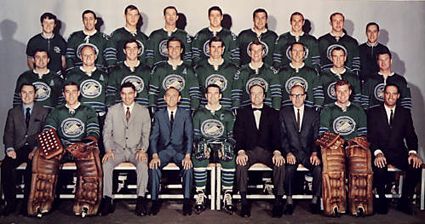

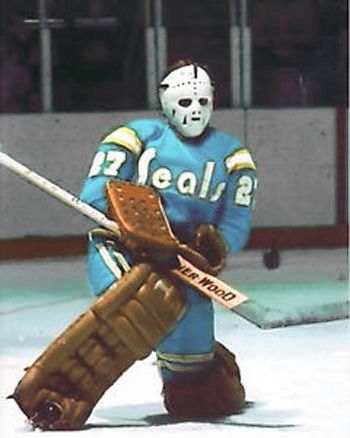
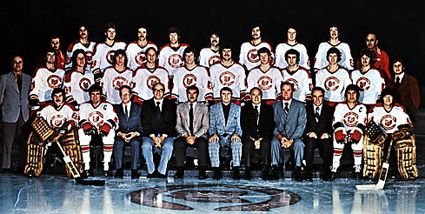
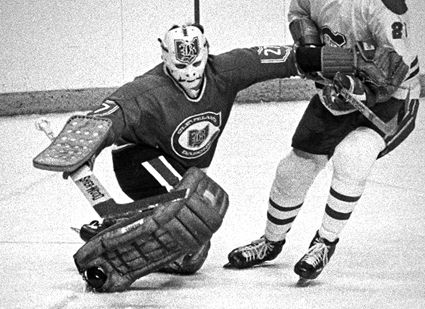
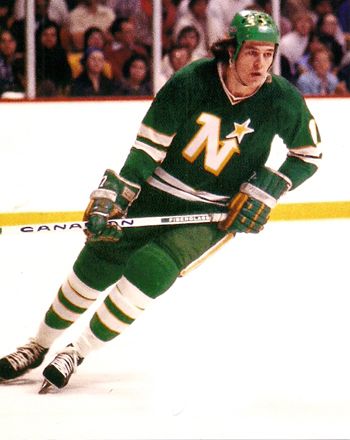
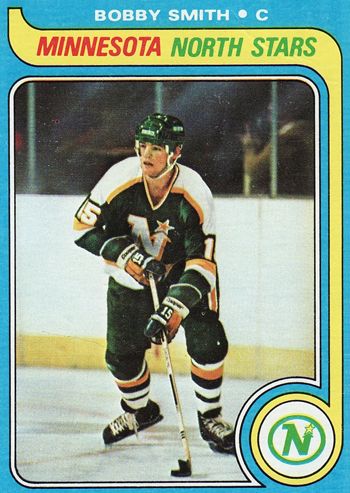
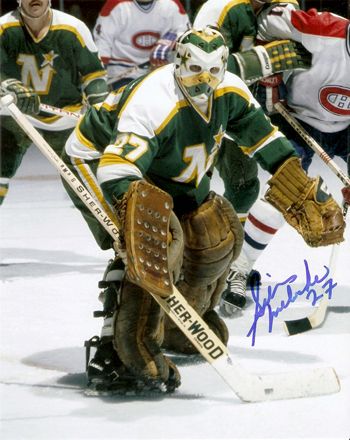

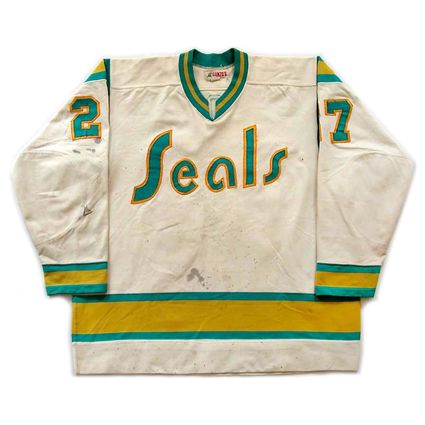

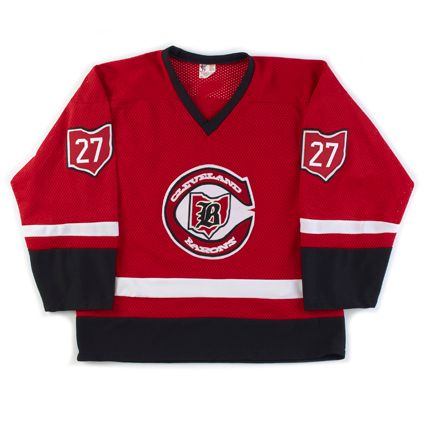
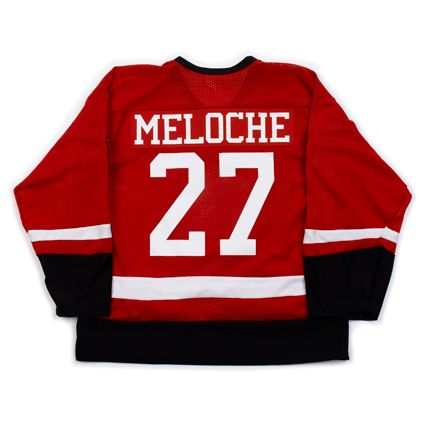












No comments:
Post a Comment
We welcome and encourage genuine comments and corrections from our readers. Please no spam. It will not be approved and never seen.